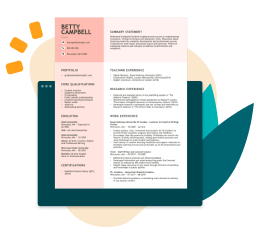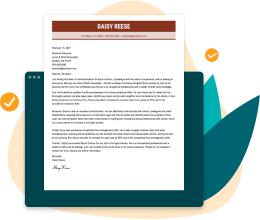How to List Language Skills on Your Resume (2025)
Showcase language skills on your resume to stand out as a valuable asset. Learn how to list them effectively and download ready-made resume examples to boost your hiring chances.
What Are Resume Language Skills?
Resume language skills showcase your ability to speak, read and write in specific languages. They’re especially valuable for customer service, healthcare and sales roles, where interacting with a diverse population is expected.
You can easily add language skills to your resume using our Resume Builder. However, to further guide you, this article will cover how to list language skills, determine proficiency levels and provide examples to enhance your resume. Let’s dive in!
How to Write Language Skills on a Resume
When writing your resume language skills, it’s not enough to simply list the languages you speak. Recruiters need to know how well you speak a language and in what context.
To build an effective resume language skills section, you have to:
- Identify which languages you speak.
- Determine whether you’re a beginner, intermediate or advanced speaker.
- Choose a language proficiency scale.
- Decide if a separate language skills section is necessary.
- Tailor your language skills to your target job.
Here’s a resume example for a translator; pay close attention to how they present their language skills in a separate section following one of the approved language proficiency scales.
The following pointers will help you correctly add language skills to your resume and show recruiters that you’re the best candidate for the role.
Levels of language proficiency on a resume
There are different levels of language proficiency: beginner, intermediate, advanced or native speaker. When listing language levels for your resume, you must adhere to an approved language proficiency scale so there’s no confusion about your level of expertise.
The following are the nationally and internationally recognized rating systems you can use to determine your levels of language proficiency on a resume, along with resume language skills examples.
ACTFL proficiency scale
The ACTFL scale consists of four levels: Novice, Intermediate, Advanced and Superior. Each level can also be divided into three sublevels: Low, Mid and High. For example, you can be an Intermediate-Mid in Spanish.
Languages
- English – Superior-High (Native)
- Italian – Superior-Mid
- Albanian – Intermediate-Low
- Hungarian – Novice-Mid
ILR proficiency scale
The Interagency Language Roundtable (ILR) created its language scale to be used by the U.S. federal government for federal jobs. It has six base levels, from 0 (No Proficiency) to 5 (Native or Fluent).
Languages
- English – Native/Bilingual (ILR 5)
- Cantonese – Full Professional Proficiency (ILR 4)
- Mandarin – Professional Working Proficiency (ILR 3)
- Arabic – Limited Working Proficiency (ILR 2)
CEFR proficiency scale
The CEFR global scale measures language proficiency in six levels: A1, A2, B1, B2, C1, C2. Levels can be grouped into Basic User (A1 and A2), Independent User (B1 and B2) and Proficient User (C1 and C2). For example, you can be a Danish B1 Independent User. Choose this scale if applying to a foreign company or when writing a college resume for a school abroad.
Languages
- British English – Native
- Russian – C2
- French – B2
LinkedIn language rating system
LinkedIn’s widely used language scale is based on the ILR language rating system. The LinkedIn language scale is simple and easy to understand. It consists of five groups: Elementary Proficiency, Limited Working Proficiency, Professional Working Proficiency, Full Professional Proficiency and Native or Bilingual. You can find this by visiting View Profile > Add profile section > Additional > Add languages.
Languages
- English: Native or Bilingual Proficiency
- Spanish: Full Professional Proficiency
- French: Limited Working Proficiency
- German: Elementary Proficiency
Where to Put Language Skills on a Resume
In a separate section
We recommend creating a separate resume section to showcase your language skills. As a recruiter scans your resume, a “Language Skills” section will quickly grab their eye and inform them you’re multilingual.
Language Skills
- French – Native/Bilingual
- English – Superior High
- Spanish – Intermediate High
In the main resume skills section
You can include your language skills in your general resume skills section, but it won’t stand out as much. Only opt for this if your foreign language proficiency is more on the beginner side or if knowing a second language isn’t relevant for the role.
In this case, it would look like this:
Skills
- Copywriting
- Social media management
- Content creation
- Reels and TikTok
- Project management
- Fluent in Spanish
In the resume summary
Including language skills in a resume summary is an excellent way to signal to employers that you have this crucial skill set. This option is also more beneficial for roles where language skills are highly relevant, such as teachers or translators.
Check out how to list languages in a resume summary:
Professional Summary
Accomplished translator fluent in English, Mandarin and French, known for precision and cultural sensitivity. Proven track record in court interpretation, literary translation and localization, delivering top-quality translations that preserve original nuance. Committed to meeting deadlines and continuous improvement. Adept at maintaining confidentiality and facilitating effective communication.
Why Should You Include Language Skills on a Resume?
Including language skills on your resume is always a good idea. According to the Society for Human Resources Management (SHRM), nine out of ten U.S. employers say they rely on employees who speak a language other than English. Employers have also reported the value of multilingual employees, from direct business impact to a richer work culture.
Here are the top reasons you should include language skills on your resume:
It’s a job requirement
A resume language skills section should be one of your top-priority sections if the role explicitly mentions you need to be proficient in one or more languages.
Speaking another language can benefit the role or company
You should include language skills on your resume if you can see the benefit of being multilingual in the position (for example, in nursing, teaching or customer service jobs.) Even if not an explicit job requirement, including a resume language skills section can set you apart from other applicants.
Showcases your knowledge and education
Being multilingual is impressive and speaks to your commitment and ability to communicate with a diverse range of people. Therefore, it’s always an excellent addition to your job application. Feel free to add a resume language skills section if you’ve included all the crucial information on your resume and still have space.
Improves customer service
Language skills are valuable for customer service and other client-facing roles because they enable you to better communicate with non-English-speaking customers. When clients encounter issues or frustrations, speaking their native language can improve your interaction and help them feel more at ease.
Aids business expansion
Speaking another language makes you an asset for companies that wish to expand their business to other markets. A multilingual worker can help negotiate with potential foreign partners and even provide cultural context to better inform business decisions.
Promotes diversity and multiculturalism
A company where everyone speaks the same language and looks the same doesn’t reflect the world we live in. Multilingual employees are an excellent resource in a job market where employees expect diversity across all company levels. Multilingual workers can aid HR during the hiring process and provide their perspective when establishing company diversity and inclusion guidelines.
These are some of the reasons why you should list any language skills you possess on your resume — they will give you a leg up over other candidates, especially since employers know they can count on you if the need for your foreign language skills arises.
Tips for Adding Language Skills on a Resume
- Choose one rating system: To ensure consistency, use a single language proficiency scale, such as ACTFL, ILR, CEFR or the LinkedIn scale.
- Label the section clearly: If you add a separate resume section for languages, use a heading like “Languages” or “Language Skills” for easy identification.
- List proficiency levels: Pair each language with its proficiency level using the chosen scale (e.g., ACTFL: Superior, CEFR: C1).
- Specify if you have native proficiency: Indicate if a language is your native or bilingual proficiency (e.g., “English – Native”).
- Order by relevance: List languages in order of relevance to the job or industry you’re applying for.
- Avoid overloading the section: Only include languages where you have functional or professional proficiency.
- Include context when necessary: For government or international roles, include the rating scale you used (e.g., ILR 5 or CEFR C2).
- Double-check for accuracy: Ensure your proficiency levels are accurate and that they match your actual abilities to avoid misrepresentation.
There you go! If you’re convinced language skills are a must-have on your resume, let our Resume Builder help you weave them into your current resume. Don’t worry about reformatting your resume; upload your file, and we’ll handle everything for you.
Key Takeaways
- Resume language skills refer to your ability to understand a language other than your native tongue.
- Including language skills on your resume can help your chances of getting hired since companies are becoming more reliant on their multilingual workers in this globalized age.
- Include resume language skills if you’re applying for a role or industry that would benefit from a multilingual person, such as law, healthcare, customer service or sales.
- You can include language skills in various sections of your resume: the professional summary, the skills section or a separate languages section.
- When listing languages on a resume, you must choose an internationally accepted language rating system.
- The most common language rating systems are ACTFL, ILR and CEFR. The LinkedIn rating scale is also widespread in the U.S. job market.
- Stick to one language proficiency rating system when listing your resume language skills to avoid confusing recruiters.
- Ensure you correctly format your language skills section and consistently display all proficiency levels.
- Save time with our Resume Builder, which automatically formats all your resume sections and suggests personalized content you can copy-paste and quickly edit in minutes.
How We Reviewed This Article
Over the past 15 years, we’ve helped more than 10 million job seekers build stronger resumes, discover their career paths, interview confidently, and boost their chances of finding the right job faster. Review our Editorial Policy to learn more about our process.
Featured in:*

*The names and logos of the companies referred to in this page are all trademarks of their respective holders. Unless specifically stated otherwise, such references are not intended to imply any affiliation or association with LiveCareer.












